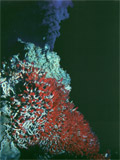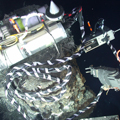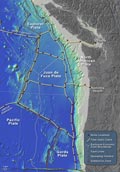mission
Introduction
VISIONS '05
Expedition to the Underwater Volcanoes of the Northeast Pacific
1 September to 4 October 2005
Please join us on our expedition aboard the Research Vessel Thomas G. Thompson to the underwater volcanoes of the Juan de Fuca Ridge in the northeast Pacific Ocean. Using the remotely operated vehicles ABE and Jason II and a high-definition underwater video camera, we will explore, sample, and map one of the most extreme environments on Earth. During this voyage, we will share with you deep-sea imagery, daily updates from the ship, new discoveries, and even poetry.
VISIONS '05, led by co-chief scientists and University of Washington Professors of Oceanography John R. Delaney and Deborah S. Kelley, involves several complex programs with science parties and science teachers from multiple institutions in the U.S. and Canada. The geographical focus of the expedition is one of the most geologically and biologically active sites in the global network of mid-ocean ridges: the suite of undersea hot springs associated with the volcanoes located in the Endeavour hydrothermal field at the northern end of the Juan de Fuca Ridge.
VISIONS ‘05 will feature the first real-time broadcast of high-definition video from the seafloor. This program is emblematic of the rapid and non-linear changes in both scientific insights and technology-based capabilities that are transforming perceptions and interactions with ocean space. High-definition video is the most capable imaging medium in existence for viewing and sharing the unparalleled deep seascapes festooned with exotic life forms that thrive on volcanic activity while living only centimeters away from 700 °F vent fluids billowing out of the seafloor.
Major components of VISIONS '05
- Exploring the limits to life in hydrothermal sulfide deposits by drilling holes and inserting an instrument known as the microbial incubator
- Documenting the linkages among deformation, venting behavior, fluid chemistry, and microbial activity along the boundaries of tectonic plates
- Conducting a program focused on professional development for K-12 science teachers
- Conducting a cable route survey for the northern portion of the NEPTUNE network
- Transmitting high-definition video imagery live from the seafloor and the ship via satellite to shore
The Concept of Ocean Observatories
This first-ever live, high-definition video transmission from the seafloor to land on September 28 and 29, 2005, provides an early example of the capabilities of the NEPTUNE (www.neptune.washington.edu and www.neptunecanada.ca ) program. NEPTUNE is a planned US/Canadian underwater observatory. An instrumented network of 2,000 miles of fiber-optic/power cable will allow researchers real-time, interactive observations of and experiments within the ocean, seafloor, and subseafloor, as well as the biological communities that thrive there. Installation of NEPTUNE is scheduled to begin in 2007.
NEPTUNE technology represents the next-generation of ocean research and will provide 24/7 remote access to the extreme environments found on the seafloor. The network will eventually enable entirely new approaches to studying and understanding the oceans: three-dimensional views of ocean and seafloor environments transmitted in real time to shore and over the Internet.
The National Science Foundation is planning and implementing ocean observatories on a variety of scales through the Ocean Research Interactive Observatory Networks (ORION) program.




